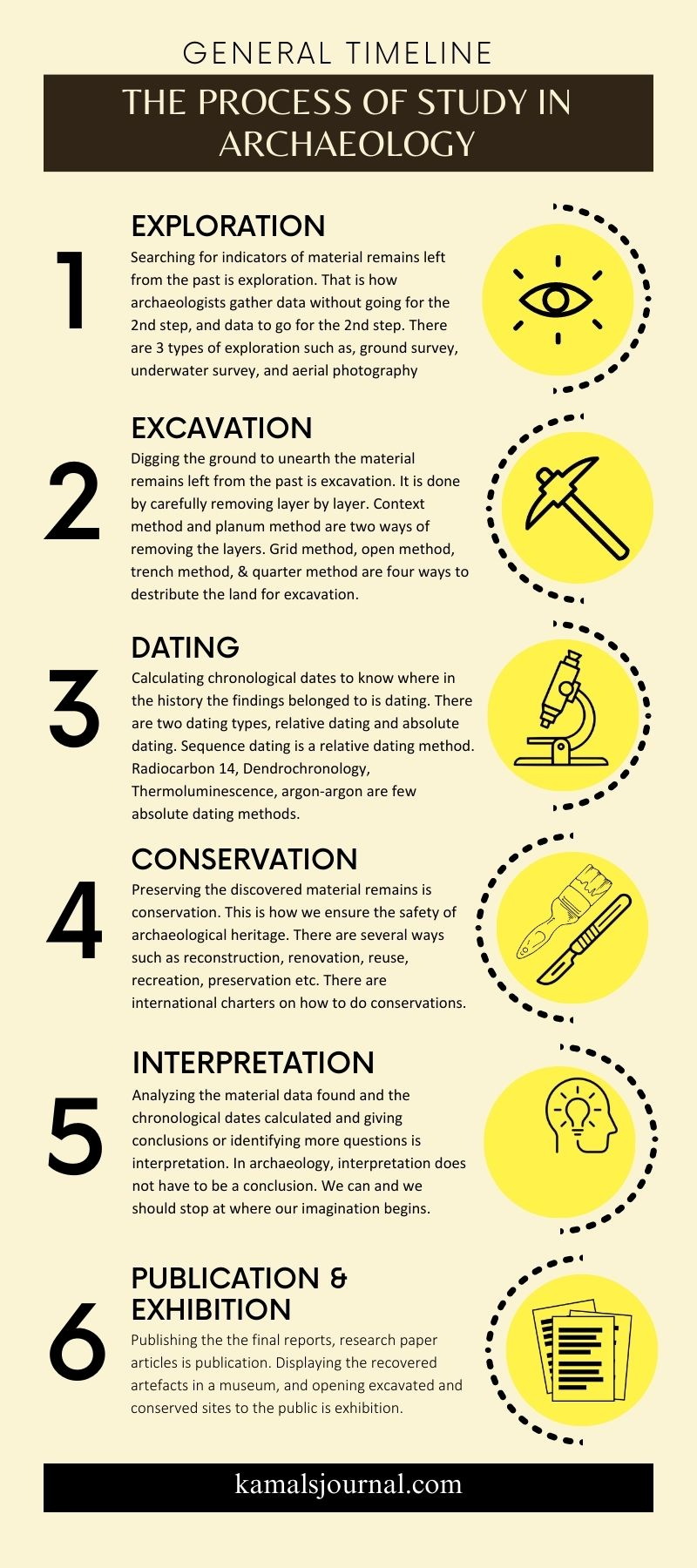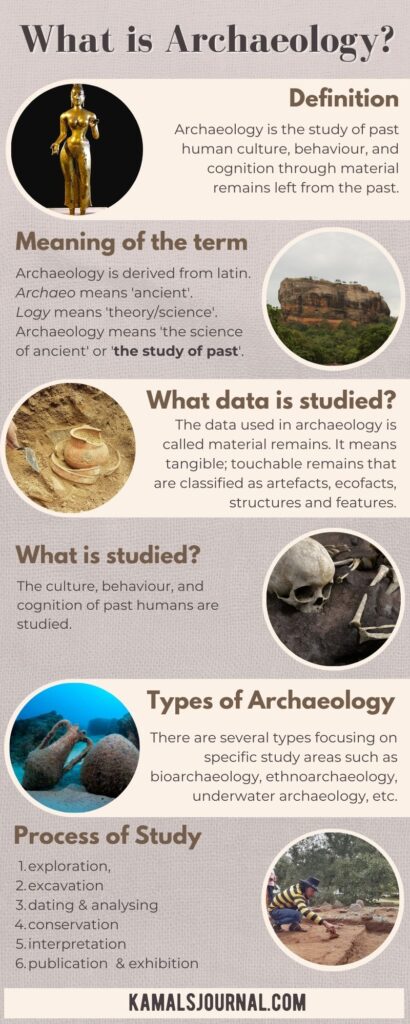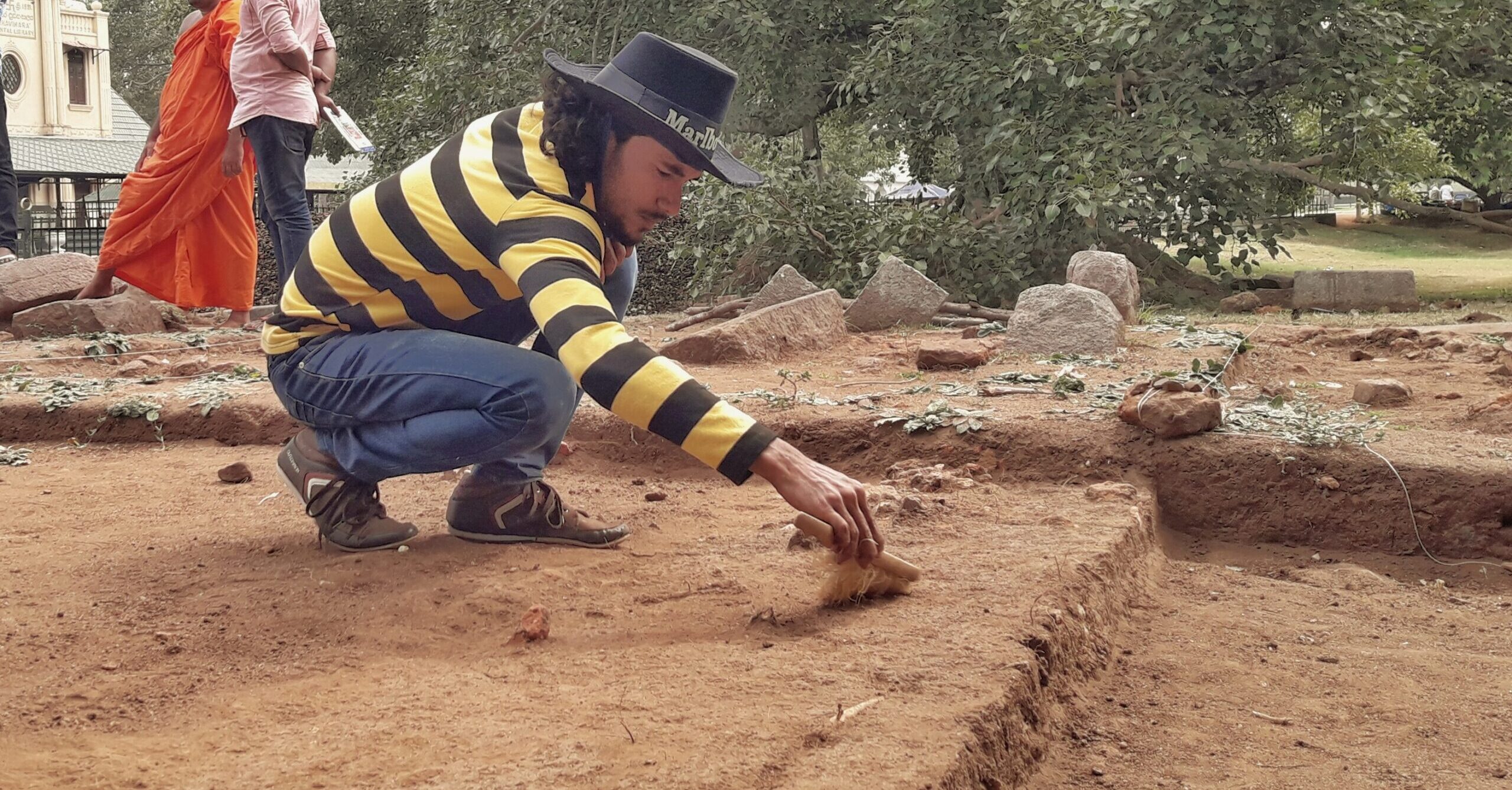In this article, a brief, simple, but complete answer will be provided to the question, What is archaeology? Also, there will be answers to commonly asked questions such as types of archaeology, what archaeologists do, and why archaeology is important.
What is the meaning of the term archaeology?
The term is derived from Latin. Archaeo means ‘ancient’ and logy means ‘the study of’. So, ‘the study of the ancient’ in the sense of ‘the study of the past’ is the meaning of the term archaeology.
And ‘aa-kee-o-luh-jee’ is how to pronounce archaeology in the British accent. ‘Aar-kee-aa-luh-jee’ is how to pronounce archaeology in American accent.
What is the current definition of archaeology?
“Archaeology is the study of past human culture, past human behaviour, and past human cognition through material remains left from the past.”
This is the answer to the question, ‘What does archaeology mean?’. This definition is explained and simplified below. Additionally, the next articles in the series will provide some information on this definition. Keep reading!
What are material remains in archaeology?
Simply put, the things we study in archaeology are those ‘that have remained from the past and can also be touched’.
As with any field or discipline, data is a necessity for study. The nature of data differs according to the field or discipline. The data we use for studies in archaeology is material remains (material means touchable or tangible objects). Therefore, we call them material data. And we identify material data in many forms, such as bones, fossils, coins, pottery, beads, building remains, paintings, murals, sculptures, inscriptions, plant and animal remains, etc. The specialty here is that the material data are remains from the past that are directly or indirectly associated with human ancestors.
There are five types of material data studied in archaeology: artefacts, ecofacts, structures, and features associated with human activity.
In summary, physical remnants that are found in archaeological sites related to past human activities are material remains.
Read more about material remains>>
What is an archaeological site?
As said in the definition, we study past human culture, behaviour, and cognition through material remains from the past. So, from where do we find these material remains? Those are from archaeological sites. But is that all? Is there an archaeological site where we can find material remains? The answer is no. Here is why.
An archaeological site is a geographical unit that holds archaeological importance. Some sites are small, while others are large. Some are underwater, and some are inland. This way, we recognise archaeological sites as the places or areas on earth that are archaeologically important.
Then, why are some particular areas on earth archaeologically important? That is because those sites have been where past human activities took place. Those can be settlements such as cities or villages, burials, cropfields, battlefields, road networks, harbours, shipping lanes, etc. Among those sites, some may have material data left, while others have no material data left. For example, a cropfield may not include any material remains. But the fact that land was used for cultivation is important in studying the human past. Therefore, an archaeological site is not always a place or area on the earth where we find material remains left from the past. Rather, it is a place or area where we obtain data about past human activities.
An archaeological site is a particular geographical area on the earth where we obtain data related to past human activities.
What are the types of archaeology? The Subdisciplines in Archaeology
There are subfields in archaeology based on the nature of the process of study and the area of study. In other words, these subfields are based on what is studied and how it is studied. Prehistoric Archaeology, Environmental Archaeology, Bioarchaeology, Underwater Archaeology, Ethnoarchaeology, Geoarchaeology, Rescue Archaeology, and so on are just a few examples. Each sub-discipline has its own characteristics in the study area, the research methodology, and the results too. And each subdiscipline is specialised in one of the subfields. The interconnection between these subdisciplines contributes to the studies accordingly.
What is studied in archaeology? The Area of Study in Archaeology
Based on those material data, we study the past human culture, the past human behaviour, and the past human cognition. Those three elements can be explained as follows:.
What is past human culture?
To make it easy to understand, the culture is usually studied by dividing it into several elements, such as the following:
- beliefs and religions
- food and subsistence patterns
- clothing
- transportation
- occupations
- the economy
- trade
- craft and technology
- social order
- gender
- art and architecture
Simply put, everything that did not naturally occur but occurred within humans in the past is studied as past human culture.
What is past human behaviour?
How humans acted and reacted in the past is past human behaviour. As an example, think about hunting. Hunting animals for food is a part of their culture, as it falls under the category of food and subsistence patterns, as mentioned above. But how they execute the hunt falls under their behaviour.
What is past human cognition?
Why humans acted and reacted in certain ways in the past is past human cognition. As an intelligent species, the culture or behaviour of humans does not occur randomly. There was cognition behind it. Take the above example. Past humans chose hunting as a way of getting food. And they chose ways of hunting. As you may know, it is said that in prehistoric times, humans hunted mamoths by pushing them from cliffs. That is their intelligence.
To understand the above three study areas, take stone tools as an example. As you may already know, past humans used stone tools. The use of stone tools was a part of their culture. It was their craft and technology. Then, how they made and used those tools was their behaviour. They used those tools to hunt, butcher, and defend. Then, why they used those tools in the ways they did was their cognition, their intelligence. They used different types of tools for different purposes: one type to hunt, another type to butcher, and another type to cut wood. They created tools out of different types of stones. And as their intelligence evolved, they developed the tools.
This way, using the material remains left from the past, we study past human culture, behaviour, and cognition, including the evolution of all three of those.
What do archaeologists do? The Process of Archaeological Study or Archaeological Process
There are a lot of things that archaeologists do. Basically, they study the material data described above. They can be studying a fossilised bone sample that is millions of years old. And also, they can be studying a hundred-year-old building or a painting in your hometown. No matter how distinct the types of studies archaeologists work on appear, they all fall into one category: archaeological research.
There are several basic steps that archaeologists generally follow when conducting a study or archaeological research.
- The first step is exploration, and that is how they gather data without going for the second step. (read more about exploration…)
- The second is excavation, and that is how they unearth the material data. (read more about excavation…)
- The third is conservation, and that is how they conserve the excavated material data.
- The fourth is dating, and that is how they determine the chronology of physical remains unearthed.
- The fifth is interpreting, and that is how they analyse the dug-up physical data and the dates taken.
- The sixth is publishing or exhibiting, and that is how the information about the discoveries comes to us as knowledge and as museum pieces.

For all of these steps, there are specific theories and methods. Also, there are other steps in between these, and sometimes these steps repeat one after another as the studies continue. And sometimes some steps are left off, according to the nature of the research. Some archaeological researches may contain only one step.
For example, archaeological reconnaissance of a selected area can be an archaeological project. In that case, archaeologists study the data retrieved by reconnaissance, analyse, interpret, and present it in research papers. Some archaeological research can be entirely based on publications and reports. For example, an archaeologist can study the metallurgy of a certain culture during a certain time using the available reports and publications. That work is quite similar to the work of a historian. But, here, the sources the archaeologist will use will be both historical records and archaeological reports, placing reliability on archaeological reports as they are the scientific, proven data available.
Why is archaeology important?
Archaeology is important because,
1. Archaeology is the fact based, scientific study of past human culture, behaviour, and cognition through material remains.
As is obvious, to study the past human culture, past human behaviour, and past human cognition, there is no other discipline as archaeology. In fact, archaeology emerged, fulfilling the requirements of studying the past. In other words, archaeology was born to serve the purpose of digging into the past. And it is scientific. It gives fact-driven insights into the past.
In fact, archaeology is the scientific discipline that reconstructs and studies the human past. To do that, archaeologists not only study material remains, but they also study written records of the past. The reconstruction of human history is the main task that historians do based on archaeological evidence and written records. In that case, the most reliable data is provided by archaeological research. And archaeological research does not stop at discovering data. It analyses, interprets, and presents information about the past on both micro and macro scales.
2. Archaeology is the scientific discipline that provides tools to deal with antiquities.
Apart from digging into the past, as seen in the history of archaeology, people dealt with antiquities or material remains left from the past. Sometimes, people loved collecting antiquities just for their artistic value, neglecting all the historical value and importance of material remains as study objects. On the other hand, to study the past, people needed to deal with antiquities or material remains left from the past. Therefore, a scientific discipline was needed. So, for whatever reason, archaeology is the scientific discipline that provides principles, methods, and tools for dealing with antiquities in a better way.
3. Archaeology is the discipline that preserves and conserves human heritage all around the world.
As archaeology evolved in the 1970s, it became the discipline that protects all the physical heritage around the world. As of today, this trend in archaeology has thrived into a new discipline called cultural heritage management (CRM). So, archaeology is the way of protecting the heritage all around the world for future generations. In fact, there is no other discipline developed in archaeology to preserve and conserve tangible cultural heritage. Charters such as Venice and Burra are brought up for the task. In fact, UNESCO world heritage sites are recognised, maintained, conserved, preserved, and conducted archaeological studies.
4. Archaeology is a discipline that does the heavy lifting behind the curtain for the world economy by ensuring the existence of a part of the tourism industry.
As you might have guessed, Most of the countries in the world still have two categories in the tourism industry. Tourists are attracted to two main things. One is a natural attraction. The other one is cultural attractions. Under cultural attractions, it can be cultural attractions for living cultures or attractions for past cultures. Regardless, cultural attractions represent heritage. If it is tangible heritage, it is obviously dealt with by archaeology, as mentioned above. Then, the intangible heritage, such as customs, festivals, and chantings, is always connected with the tangible heritage.
For example, the temple of the tooth in Sri Lanka, which is no. 1 on the tourist attraction list in the world by January 2024, is a tangible heritage. The annual Esala Perahera, Kandyan dance, oil lamps, elephants, and all the customs fall into the intangible heritage of the temple of the tooth. Both tangible and intangible heritages are interconnected. The tourist attraction is for both. In fact, the present day tourism industry in Sri Lanka depends on its cultural and natural heritage alone.
So, a major part of the tourism industry in the world depends on archaeological heritage management. And with that, the cultural heritage is preserved and conserved for future generations, as is the continuity of the cultural heritage-based tourism industry for future generations.
5. Archaeology is the scientific discipline that provides information about the identities of countries, nations, and communities.
History or the past, is not something about which many of us are not concerned. Digging into the past comes from human nature. But, though some of us are not ready to accept it, written history is not 100% accurate. Sometimes it can be fiction. So, the real identities of land, people, countries, nations, and communities are not so clear. But archaeology can provide information about the real identities of all of those entities.
6. Archaeology is the scientific discipline that provides data for social studies.
Disciplines such as sociology, anthropology, ethnography, etc. require data for people who lived in the past. For example, the functional theory in sociology speaks about the function of society in its forms from the earliest times. They use the data from prehistoric archaeology and classical archaeology to form the functional theory. Likewise, many social studies need scientific data about past humans, and archaeology is the way to get it.
7. Archaeology is the only scientific discipline that provides the most realiable data and the most reliable fact-based truths about the human past.
As mentioned above, history can be misleading. It should not be that way, but it has been all along. Because the literature is not science-based historical records. The concepts of nationalism and religious beliefs have led people to have their own histories as identities. That can sometimes divide people rather than unite them. And also, that can start conflicts regarding the ownership of land. But archaeology is a scientific discipline where we study human history as unbiased scholars based on facts. So, archaeology can eradicate false accusations, false ownership, and wrong impressions about ownership and heritage.
For example, according to written history, the northern Indian Buddhist migrations that happened after the 4th century BC brought civilization to Sri Lanka. Further, the literature says that they brought all the crafts and technologies with them. But the archaeological excavations discovered pottery pieces that date back to the 6th century BC. And most of the pottery pieces found in Sri Lanka belong to the types called redware (RW) and black and redware (BRW), which were popular in south India, not north India.
Also, the epigraphical studies showed that there was good communication and civilization before the Buddhist migrations. Even iron-smelting sites such as Samanalawewa were discovered and those were practically tested by archaeologists. So, the popular history of Sri Lanka proved to be false. And it became clear that Sri Lanka and India had connections in the most practical way as early as the 10th century BC. And the epigraphical studies in India and Sri Lanka showed that the earliest languages and alphabets had common roots and were influenced by each other.
So, it became clear that, during the time of the kings, the two lands disturbed each other with invasions, but from the beginning they shared much valuable culture. This way, archaeology can reveal the truth about the past, showing that people as a human race are connected and share the same roots. So, archaeology, under well-disciplined scholars, without the tiniest interference from politics, is like a key to showing the world that the human race is equal and connected rather than divided. Any division we may see is an identity, not a margin of division.
Summary
So the answers to the questions of what, how, and why archaeology is studied are now clear. So, what is studied in archaeology is past humans; how it is studied in archaeology is through studying material remains; why study archaeology is to know the past human culture, behaviour, and cognition; and why archaeology is important is to reveal history in a scientific way. In other words, what they had is their culture; how they act is their behaviour; and why they had that particular culture and behaviour is their cognition. Therefore, the simplest answer to the question of what is archaeology is that ‘the study of past human culture, past human behaviour, and past human cognition based on material data is archaeology’.

Anyone interested in understanding this captivating discipline further, should study the history of the development of the definition of archaeology or the history of archaeology.
Read the article>> History of Archaeology: Origin of Archaeology

